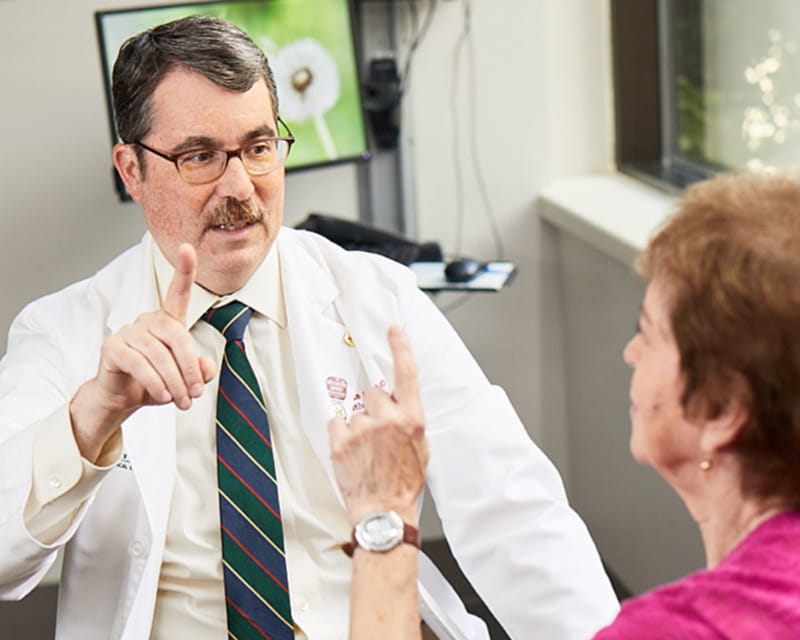
Ohio State researchers identify new biomarkers that differentiate Lewy body dementia from Alzheimer’s and Parkinson’s
 It’s the most common disabling neurological condition, driving millions of people each year to seek care from emergency departments, neurologists and primary care providers. Yet many people with disabling headache may be experiencing long delays to get care, with ineffective and disjointed care management, even as newer and more effective treatments are becoming available.
It’s the most common disabling neurological condition, driving millions of people each year to seek care from emergency departments, neurologists and primary care providers. Yet many people with disabling headache may be experiencing long delays to get care, with ineffective and disjointed care management, even as newer and more effective treatments are becoming available.
The Division of Health Services Research in the Department of Neurology at The Ohio State University Wexner Medical Center is looking at all the reasons why — and designing a streamlined model of care with the intent of helping patients with headache get needed relief promptly and effectively. Fittingly named the PROMPT (PeRsonalized Option-based Multi-specialty multi-Platform and Timely) model of care, it aims to make better use of resources and treatment options, to greatly improve quality of life for people who suffer from chronic headaches and reduce the burden of care.
“Our team did a national study and found that only 35% of headache visits are with neurologists,” says Kevin Kerber, MD, a neurologist and co-director (with James Burke, MD), of the Health Services Research Division. “The rest are with primary care physicians or other providers. Other studies have found that non-headache specialists may not focus enough on providing evidence-based care or stay up to date on the latest strategies and therapeutic agents, which is a challenge when rapid progress is being made. For instance, health conditions that can cause or increase headaches — such as sleep apnea or obesity — are often not identified or addressed.”
Evaluating the initiative is a key element of the team’s approach, an element that’s often missed or inadequate with clinical initiatives in general, Dr. Kerber says. If early success is any indication, the new care model could transform the way chronic headache conditions —such as migraines or cluster headaches — are managed and treated. It could also be adapted and applied to other chronic conditions requiring complex, advanced or specialized care.
With more than 5,000 visits each year, the Ohio State headache clinic is working to reduce wait times, and the PROMPT model of care could help. The Neurology Department’s Division of Health Services Research has applied for a Patient Care Innovation award from the Ohio State Wexner Medical Center to expand and continue its use and evaluation — particularly for Medicaid patients, who experience longer wait times for appointments, about 20% higher than those for patients with managed care.
Even as treatment and prevention options proliferate, the evidence-based tenets of headache care are well-established:
These standards haven’t changed, but access to care is often an insurmountable challenge. In the current model of care, no headache specialty care is provided until the office visit, which often takes place months after referral. Because of the volume of patients seeking care for headache and the variety of barriers they may face, even increasing the number of specialists nationwide couldn’t feasibly meet the demand. The result: Patients often enter a “dead zone” with little guidance or care for weeks or even months after referral. This access problem may be one reason many new patient appointments get canceled or turn out to be no-shows.
“With a lag time of nearly 90 days, a model based solely on office visits is inefficient for the patient and the provider,” Dr. Kerber says. “To improve access to specialty care, we must increase efficiency in care delivery. Providers get frustrated with circumstances where we don’t really have great ways to triage referrals as they come in, and also, we don’t necessarily like to repeat ourselves all day. But the structure of the current organization and financing of health care is set up in a way that makes improvements in those areas a bit of a challenge.”
The PROMPT model of care takes on the challenge in a number of ways. The acronym summarizes the care model:
“There is a lot of headache care that can be provided without an office visit,” Dr. Kerber says. “Things like e-consults, telemedicine or even group clinics are not novel in and of themselves. But we’re working to package it in a way that patients can actually select resources and tools based on what they fill out in the intake form, and we’re evaluating the results for individual patients and for the entire population.”
Evaluating outcomes is a major focus of the PROMPT care model project.
“People come up with ideas all the time, but if you don’t actually evaluate them, you might be making things worse rather than better,” Dr. Kerber says. “So, we’re trying to come up with an intervention, and then we want to evaluate the intervention.”
The primary outcome to be measured is access. To see if access has truly improved, the team counts days from referral to entry on the medical record of a new patient Evaluation and Management Code. Secondary outcomes to be measured include:
If the PROMPT model is deemed successful for treating and managing headache, it may be adapted and applied to other conditions as well.
At Ohio State, Dr. Kerber and Dr. Burke are well-positioned to adapt, apply and evaluate the PROMPT model of care. Few institutions offer innovation awards to enable health services research, and Dr. Kerber, whose primary clinical interest is dizziness, has a record of health services research. He and his team recently completed a study on the use of neuroimaging in diagnosing dizziness and another measuring the incidence of stroke after discharge from the emergency department for dizziness.
This research takes a team of clinicians from various backgrounds, such as neurology and primary care, in addition to the research team, including a manager, research coordinator and data analysts. The team members also need to be able to engage with patients for feedback and general participation.
“We’ve already done similar work applying the PROMPT concept for dizziness,” Dr. Kerber says. “In addition, conditions like neuropathy, cognitive disorders and seizures may be more manageable if we look at changing the model of care, instead of focusing solely on new pharmaceutical agents or increasing the number of providers.”

Ohio State researchers identify new biomarkers that differentiate Lewy body dementia from Alzheimer’s and Parkinson’s

Biomarker breakthroughs at Ohio State transform disease diagnosis, predictability and treatment

The Ohio State University Wexner Medical Center pushes boundaries for neurological care